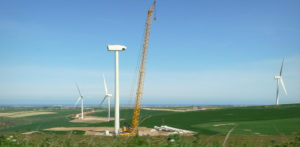
From coast to coast, America’s economy kicked into high gear in 2018—and the clean energy sector had a record year, too. The Business Council for Sustainable Energy’s recently released 2019 Sustainable Energy in America Factbook documents strong trends in clean energy and a need for continued federal policy support that leverages private sector investment to accelerate emissions reductions.
For years, the rapid growth we have seen in energy efficiency, natural gas, and renewable energy drove down U.S. greenhouse gas emissions (now 10% below 2005 levels) while the economy grew. That’s why it was frustrating to see energy productivity (the ratio of U.S. GDP to energy consumed) stagnate and 2018 economy-wide U.S. greenhouse gas emissions increase by over 2 percent from the previous year.
Natural gas and renewable energy surged in 2018. Domestic gas production reached record numbers, and U.S. liquefied natural gas exports grew by an astonishing 135% year-over-year. Amidst continued price drops for renewable power and storage, over 19 gigawatts (GW) of new renewable installations—mainly wind and solar—came online last year.
Perhaps most impressive is what’s happening in corporate America. In 2018, businesses signed contracts for 7.7 GW of wind and solar power, more than doubling the previous record from 2015. Last year also saw growth in the number of businesses joining new initiatives to demonstrate leadership in energy efficiency.
While the overall carbon intensity of the U.S. power sector continued to decline, it’s clear that achieving significant emission reductions in other sectors such as buildings, industrial, and transportation may be more challenging without policy support. Policies that streamline clean energy development, provide clear and sustained market signals, and embrace market-based regulatory approaches can reduce greenhouse gas emissions while supporting the interests of the free market.
The urgency of the challenges in infrastructure, resilience, and emission reductions appear to be increasing the appetite for clean energy and climate change legislation on both sides of the aisle on Capitol Hill. With the right blend of federal, state, and business leadership, we can see faster clean energy development, leading to more jobs, economic growth, and reduced emissions across the U.S. economy.
Most states already have approaches that stimulate the private sector in energy efficiency and renewable energy including Renewable Energy Portfolio Standards (RPS), tax credits or waivers, green banks, and govern… Read more »
The answer to all your questions is a steadily rising carbon tax where 100% of the collected revenues are returned to every legal resident on an equal basis (“Fee and… Read more »
Currently no emissions-related policy has scientific support. The widely held belief that an emissions related policy does have support is based upon the argument that is made by a modern… Read more »
Broad based support for real change has been there for quite a few years. A University of Michigan poll in 2015 … Key findings include: • A strong majority (74… Read more »